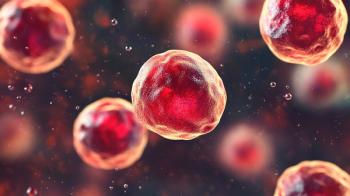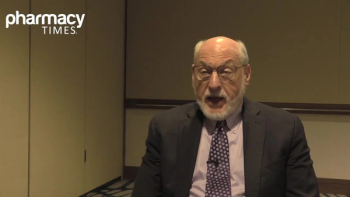
Pharmacy Practice in Focus: Oncology
- February 2023
- Volume 5
- Issue 2
NSCLC May Be an Increasingly Biomarker-Driven Disease
An expert shares information on risk factors and controversies around testing.
The incidence of lung cancer in the United States has decreased over the past few decades, according to Scott Soefje, PharmD, MBA, BCOP, FCCP, FHOPA, director of pharmacy cancer care services and assistant professor at Mayo Clinic in Rochester, Minnesota, during a Pharmacy Times® clinical forum. Soefje explained that this decline in incidence is primarily due to the efforts of antismoking campaigns in the 1990s.
Today, non–small cell lung cancer (NSCLC) accounts for 85% of all lung cancers, Soefje explained. The other type of lung cancer is small cell, which has more aggressive tumors but is considered curable. However, NSCLC, especially in advanced stages, is not considered curable, according to Soefje.
“The 5-year survival rate [for patients with NSCLC] has actually increased dramatically since I was a resident,” Soefje said. “In 1992, the 5-year survival rate was [approximately] 20%, and now we’re pushing 65% to 70%.”
However, with metastatic disease, the 5-year survival rate has remained at 8% to 10% since 1992, according to Soefje. “One of the things that’s very important about this disease is the screenings are starting to pick up because what we know is, if you catch this disease early, if you can surgically resect it, [the patient has] a much higher chance of surviving than if it gets to be locally advanced or metastatic,” Soefje said.
Furthermore, Soefje explained that among the 3 main subtypes of NSCLC (adenocarcinoma, squamous cell carcinoma, and large cell carcinoma), an interesting evolution has occurred over the past 30 to 40 years. “Right now, adenocarcinoma makes up [approximately] 40% of the cases and is less associated with smoking. So why has this been increasing? It’s interesting. Squamous cell [carcinoma] is about 25%, and large cell [carcinoma] is about 10%. If you’re like most pharmacists, you add that up and it doesn’t reach 100%. The remaining [cases] tend to [involve] these mixed-type tumors where they’ll have both [squamous cell carcinoma and large cell carcinoma]; they’ll have components or multiple different ones. When I was a resident in 1992, squamous cell [carcinoma] was 60% of the tumors, and there has been a change in the histology of lung cancer over the [past] 30 or 40 years. Again, we believe this is predominantly due to the decrease in smoking, because squamous cell [carcinoma] is most associated with smoking.”
Soefje explained that besides smoking, other risk factors for lung cancer include occupational exposures such as arsenic and asbestos. “Most of us know the stories about asbestos and mesothelioma, but asbestos can actually cause other [diseases],” Soefje said.
Soefje further explained that the occupations with the most asbestos exposure are no longer those that encounter insulation in buildings or homes. Instead, the occupation with the most exposure is car mechanic. “Brakes are still made up of asbestos in many instances,” Soefje said. “So if you have a patient [who]’s a mechanic and they’re coming in with a lung nodule, you may suspect asbestos exposure. Now those are beginning to decrease as well, [because] they’re beginning to take it out of [cars] as much as they can.”
For other risk factors, Soefje explained that personal history and family history of cancer also play a role. Specifically, having a first-degree relative with lung cancer increases the chance of a patient getting lung cancer. This is common in all cancers.
Additionally, chronic lung disease, particularly chronic obstructive pulmonary disease or pulmonary fibrosis, causes increased inflammation that triggers the immune system. In many cases, this increased level of inflammation can increase the risk of developing cancer, Soefje explained.
Furthermore, radiation exposure is another risk factor for NSCLC. For example, adults who had Hodgkin disease as children and received chest radiation are developing lung cancer years later as a secondary malignant tumor. Additionally, there are instances of NSCLC development at sites with extensive radiation exposure, such as Chernobyl in Ukraine and Hiroshima and Nagasaki in Japan.
“Testing is important because what is happening with lung cancer is it is becoming a biomarker-driven disease,” Soefje said. “I keep reminding my students [that] the most expensive drug in the world is the one that doesn’t work. If we know we have a medication that has a biomarker and it works, that’s what we want to target.”
Soefje noted there are many predictive biomarkers in lung cancer, such as ALK rearrangements; BRAF point mutations; and EGFR, RET, and ROS-1 mutations. “In fact, we believe there are probably 40 to 50 mutations that cause lung cancer. So over time we’re probably going to identify tar gets for all those at some point,” Soefje said.
Soefje also noted that PD-L1 expression is a predictive immune biomarker, but there remains some controversy around measuring PD-L1 levels. Although lung cancer is one of the few areas for which molecular testing is recommended to be done as a panel (defined as 4 tests or more), most payers won’t currently pay for it. However, despite the controversy, National Comprehensive Cancer Network guidelines recommend biomarker testing for lung cancer.
“There are also some sophisticated tests that are going on, looking at what we should be doing as panels,” Soefje said. “There’s a study at Yale New Haven Hospital where every patient who walks in the door [who] has lung cancer gets a test of 400 genes. And every time they progress, their progressive disease is tested to see how it changed. So what we believe [are] the biomarkers may evolve and change over time. It’s an interesting thought.”
Articles in this issue
over 2 years ago
Oncology Pharmacists Bring Value and Contribute to Cancer Careover 2 years ago
Melanoma Armamentarium Progresses Toward Precision TherapyNewsletter
Stay informed on drug updates, treatment guidelines, and pharmacy practice trends—subscribe to Pharmacy Times for weekly clinical insights.



















































































































































































































